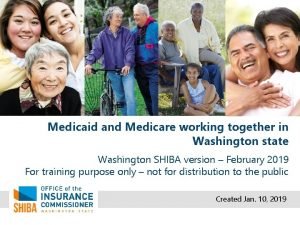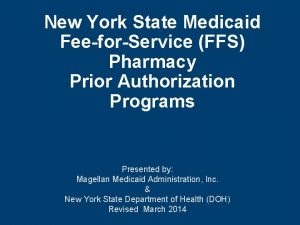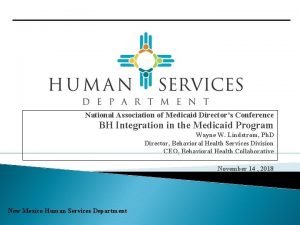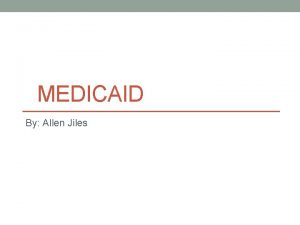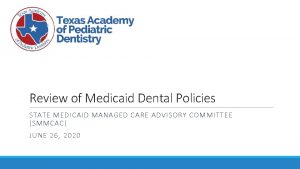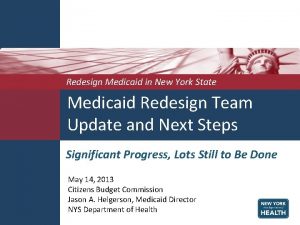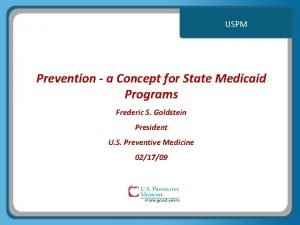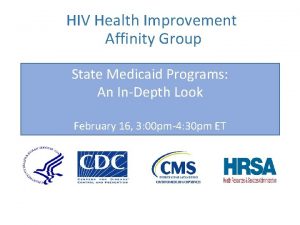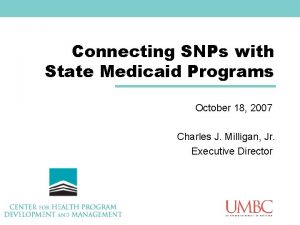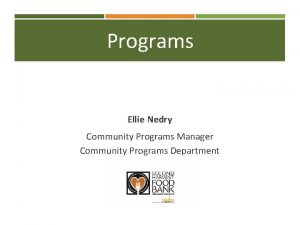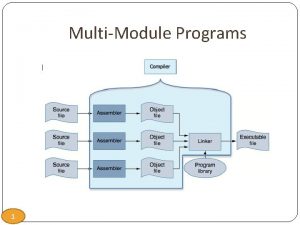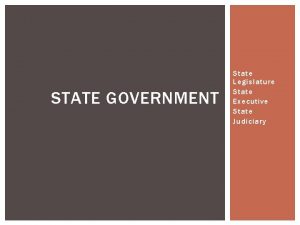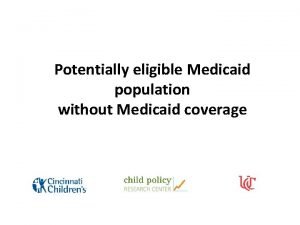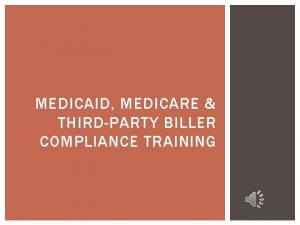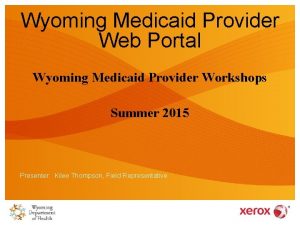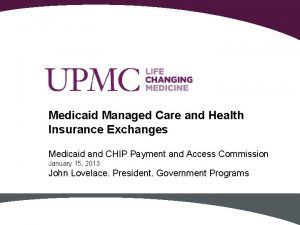The State of Medicaid Programs Medicaid A Primer




















- Slides: 20

The State of Medicaid Programs Medicaid: A Primer on the Federal-State Partnership Alliance for Health Reform| Kaiser Family Foundation March 4, 2011 Dr. Andrew Allison, KHPA Executive Director President, National Association of Medicaid Directors

Overview • • A state’s definition of Medicaid Impact of the Affordable Care Act (ACA) on Kansas State Medicaid programs in the new economy Next Steps for States 2

A Working Definition of Medicaid • Medicaid is an optional source of matching funds for states wishing to purchase healthcare for selected populations – Federal share varies from 50%-90% – Opting out is hard to do… – It is a payment source, but is thought of as an insurance product – Run by states, governed jointly – Strings are attached: lots of them – Over half of Medicaid spending used to be “optional” 3

A Statement of Purpose for State Medicaid Programs • Use of state and federal matching funds to meet the state’s greatest health needs. 4

Potential Impact of the ACA on Kansas 5

▲ 96, 000 ▼ 191, 000 ▲ 73, 000 ▲ 131, 000 ▼ 108, 000 6

Affordable Care Act: Impact on State Spending in 2020 State options regarding direct spending for the safety net* Maintain all state Reduce state spending Eliminate state spending on the safety net by spending on the safety net half safety net Point estimate plus 5% provider rate increase $35 M $12 M -$8 M Upper bound estimate of coverage $7 M -$16 M -$35 M $4 M** -$19 M -$39 M Point estimate Additional risk: +/- $15 million variance in true cost of Medicaid benefit package. Impact subject to state choice and federal regulation over covered benefits. *Options are illustrative and do not reflect the opinions of KHPA staff, nor the KHPA Board. State spending totals for the uninsured through the safety net are preliminary ($40 -$45 million annually). 7 **To the estimate from the actuaries model, this adds new administrative costs and reductions in DSH spending.

Sources of Growth in Medicaid Spending 2011 vs. 2020 $4 Federal reforms (nondisabled; non-aged) 189; $1 138; $0 Growth in number of disabled and aged (4. 3% per year) Baseline growth in costs (3% per year) (estimates in $ millions) Note: Assumes no additional reduction in state spending on the uninsured, and no increase in Medicaid provider rates. 8

Affordable Care Act Implementation: State Responsibilities • Implement insurance reforms – decide whether to accept the responsibility and opportunities that come with the establishment of an exchange – define what kind of competition they want inside the exchange – decide how to govern these new and potentially dominant health insurance markets – decide whether, and how, to use the buying power and regulatory influence they have been given in Federal legislation • Coordinate Medicaid and the new exchange(s) – ensure access to coverage – seamless transitions between different sources of coverage – link Medicaid’s insurance market with the new private insurance market? • Determine Medicaid’s new role in the health care system – simplify eligibility and select benefit package for Medicaid expansion group – set Medicaid payment rates and secure access to providers • Respond to numerous grant and demonstration project opportunities 9

State Medicaid Programs in the New Economy 10

Fundamental Shifts in the US Economy 50% Percentage of US Population that is Employed Source: Current Employment Statistics Survey, BLS: US Bureau of Census 45% 40% 35% 30% 25% 11 20 08 20 05 20 02 20 99 19 96 19 93 19 90 19 87 19 84 19 81 19 78 19 75 19 72 19 69 19 66 19 19 63 60 19 57 19 54 19 51 19 48 19 45 19 42 19 19 39 20% 11

Medicaid’s Growth Outpaces the National Economy 3. 0% Total Medicaid and CHIP Spending as a Percentage of GDP Sources: National Health Accounts, HHS; US National product and Income Accounts, BEA 2. 5% 2. 0% The only reduction came in 2006, when $billions in prescription drug spending were shifted into Medicare Part D 1. 5% 1. 0% 0. 5% 0. 0% 66 19 68 19 70 19 72 19 74 19 76 19 78 19 0 8 19 82 19 84 19 86 19 88 19 90 19 92 19 94 19 96 19 19 98 00 20 02 20 04 20 06 20 08 20 12

Recent Growth in Medicaid Spending in Kansas $1, 400, 000 Population Expenditures 2005 -2010 $1, 200, 000 $1, 000, 000 $800, 000 $600, 000 $400, 000 $200, 000 $0 Aged 2005 Disabled 2006 2007 2008 Families 2009 2010 Medikan CHIP Other 13

Potential Growth in Kansas Medicaid 14

Concentrations of Program Dollars in Kansas 15

Next Steps for States 16

Medicaid Cost Containment: Options Avoiding unnecessary spending • Available approaches to reduce Medicaid spending – Reduce payments – Reduce eligibility – Reduce range of services offered – Lower utilization through appropriate management and improved services • Limitations on state flexibility – Eligibility maintenance of effort (MOE) requirement began in ARRA and was made permanent in the ACA – Potential legal restrictions on state flexibility to reduce payments – Vast majority of optional spending is for services that either improve health , lower overall costs, or could be protected by the MOE • Remaining options are to redesign program payments, coordinate care, address unnecessary utilization and ensure positive incentives for both consumers and providers to achieve high quality care 17

What if it isn’t enough? • Title XIX was created in the fifth straight year of job growth, and during a 10 -year stretch of continuous job growth • Medicaid was expanded over 45 years of relative economic growth, including a few recession/recoveries – Passage of the ACA is a major exception • Previous discussions about the role of Medicaid in economic downturns focused on the short-term nature of recessions, unemployment and related enrollment spikes • Maintaining baseline growth in Medicaid will require a new level of tax burden in many states, and at Federal level • Controlling spending may require revisiting Federal requirements 18

Crunch Time for Medicaid • Senate version of reform transferred the health reform debate to states, who must now make many key decisions, including the decision to initiate a very challenging implementation • The fiscal base for both the ACA and Medicaid is weak – States are approaching fiscal crisis at varying speeds – Sustainability of Title XIX (Medicaid) is now in jeopardy • States will need to explore the relationship between Medicaid’s costs, needed reforms, and the ACA • States will need either more money or more flexibility in order to balance their budgets • Deadlines for tough state decisions are fast approaching 19

http: //www. khpa. ks. gov/ 20
 Cpmcd full form
Cpmcd full form Shiba rainbow chart
Shiba rainbow chart Emedny formulary
Emedny formulary National association of state medicaid directors
National association of state medicaid directors Jody robbins
Jody robbins Hát kết hợp bộ gõ cơ thể
Hát kết hợp bộ gõ cơ thể Ng-html
Ng-html Bổ thể
Bổ thể Tỉ lệ cơ thể trẻ em
Tỉ lệ cơ thể trẻ em Voi kéo gỗ như thế nào
Voi kéo gỗ như thế nào Tư thế worm breton
Tư thế worm breton Alleluia hat len nguoi oi
Alleluia hat len nguoi oi Môn thể thao bắt đầu bằng từ chạy
Môn thể thao bắt đầu bằng từ chạy Thế nào là hệ số cao nhất
Thế nào là hệ số cao nhất Các châu lục và đại dương trên thế giới
Các châu lục và đại dương trên thế giới Công của trọng lực
Công của trọng lực Trời xanh đây là của chúng ta thể thơ
Trời xanh đây là của chúng ta thể thơ Cách giải mật thư tọa độ
Cách giải mật thư tọa độ Làm thế nào để 102-1=99
Làm thế nào để 102-1=99 độ dài liên kết
độ dài liên kết Các châu lục và đại dương trên thế giới
Các châu lục và đại dương trên thế giới

